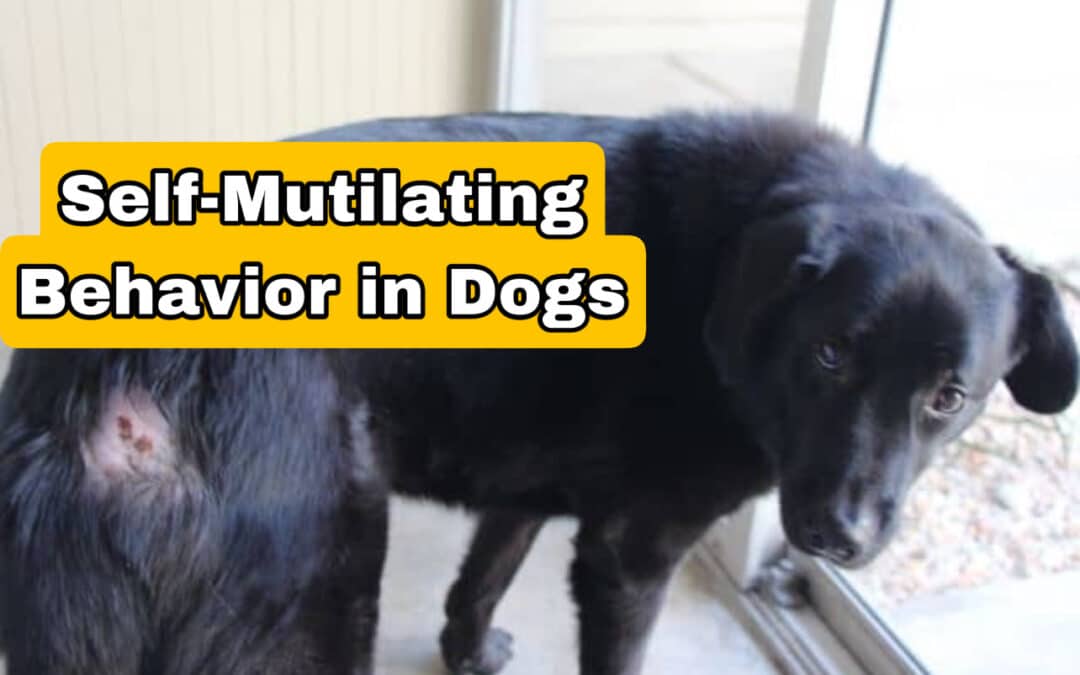Psychological Perspectives on Canine Self-Mutilation
Introduction The bond between humans and dogs is one that transcends time, cultures, and societal norms. As our knowledge of canine cognition and emotionality grows, so does our understanding of the complexities surrounding their mental health. Just as humans suffer from various psychological disturbances, dogs, too, can exhibit behaviors indicative of emotional distress. One such behavior is self-mutilation.
Background on Canine Cognition and Emotionality Dogs are known for their remarkable cognitive abilities, ranging from problem-solving skills to emotional intelligence (Hare & Tomasello, 2005). They can sense human emotions, respond to our cues, and even exhibit empathy. Understanding the depth of canine cognition provides a backdrop against which self-mutilating behavior can be better understood.
The emotional spectrum of dogs, similar to humans, is vast. Studies show that dogs can experience primary emotions like joy, fear, anger, disgust, and even secondary emotions like jealousy (Morris, Doe, & Godsell, 2008). These emotions can be influenced by their environment, experiences, and genetic factors.
Overview of Self-Mutilation in the Context of Mental Health Self-mutilation in dogs is a behavior wherein they inflict harm upon themselves, typically through biting, chewing, or scratching (Luescher, 2003). This behavior is often indicative of underlying psychological disturbances. It can be a cry for help, a manifestation of anxiety, or a result of traumatic experiences.
The Canine Mind
- Cognitive Processes in Dogs: Dogs exhibit cognitive processes that can be observed in tasks that test their memory, attention, perception, and reasoning (Fugazza, Pogány, & Miklósi, 2020).
- Emotional Spectrum and Its Implications: The emotional world of a dog is intricate. While they might not have the full range of human emotions, they certainly exhibit behaviors indicative of joy, sadness, fear, and love (Siniscalchi, d’Ingeo, & Quaranta, 2018). The understanding of these emotions is crucial as they directly influence behaviors, including adverse ones like self-mutilation.
Root Causes from a Psychological Angle
-
Traumatic Experiences and Their Aftermath:
Dogs, like humans, retain memories of traumatic experiences. Events such as abandonment, abuse, or exposure to violent incidents can leave deep-seated psychological scars. A study by Dreschel (2010) found that dogs with traumatic histories displayed heightened levels of anxiety compared to those without. This anxiety can manifest in various behaviors, with self-mutilation being one of the extreme reactions.
-
Obsessive-Compulsive Behaviors in Dogs:
Canine Compulsive Disorder (CCD) is a condition wherein dogs exhibit repetitive, compulsive behaviors, self-mutilation being one of them (Tynes, Sinn, & Hart, 2014). The origins of CCD can be multifactorial, stemming from genetic predispositions, early-life experiences, or specific triggers in their environment.
-
Impact of Stressors like Confinement, Isolation, and Environmental Changes:
Environmental stressors significantly influence a dog’s mental well-being. Long durations of confinement can induce feelings of frustration and anxiety. Isolation, especially in socially inclined breeds, can lead to depression and related self-harming behaviors. Additionally, abrupt environmental changes – like shifting homes, the introduction of a new pet, or the loss of a companion – can be destabilizing. Studies by Overall (2001) indicate a correlation between environmental stressors and self-mutilating tendencies in dogs.
Behavioral Diagnosis
-
Observational Methodologies:
Identifying self-mutilation in its early stages is crucial. Veterinarians and dog behaviorists often employ a combination of direct observation and owner interviews. Tools like video surveillance can capture the dog’s behavior in its natural environment, providing invaluable insights (Houpt, Honig, & Reisner, 1996).
-
Comparative Analysis with Other Compulsive Behaviors:
Differentiating self-mutilation from other compulsive behaviors is essential for accurate diagnosis and treatment. Comparative behavior analysis helps in distinguishing these behaviors and understanding their root causes (Moon-Fanelli & Dodman, 1998).
Therapeutic Approaches
-
Cognitive-Behavioral Therapy for Dogs:
Cognitive-behavioral therapy (CBT) isn’t limited to humans; it’s gradually finding its footing in canine therapeutic regimens as well. The primary principle is identifying and rectifying negative behavior patterns. CBT for dogs revolves around desensitizing them to triggers and teaching coping mechanisms. In a study by Todd (2018), canine CBT was found effective, particularly when combined with positive reinforcement training methods.
-
Use of Anxiolytics and Antidepressants:
Medication is sometimes an essential component of treatment, especially for severe cases. Drugs like fluoxetine and clomipramine have shown efficacy in treating canine self-mutilation and related obsessive-compulsive behaviors (Irimajiri, Luescher, & Douglass, 2009). However, it’s paramount to ensure these are used in tandem with behavioral therapies and under strict veterinary guidance.
-
Role of Training and Behavior Modification:
Rehabilitating a dog exhibiting self-mutilating behaviors requires a multifaceted approach. Dog training sessions, grounded in positive reinforcement, can help reduce anxiety and build trust. Techniques like counter-conditioning and systematic desensitization, as detailed by Lindsay (2000), are beneficial in redirecting negative behaviors.
Prevention and Education
-
Importance of Early Socialization:
The significance of early socialization in puppies cannot be overemphasized. Properly socialized dogs are less likely to develop anxiety disorders and related behaviors. Scott & Fuller’s (1965) seminal work highlighted the critical periods in a puppy’s life when they are most receptive to socialization.
-
Educating Pet Owners on Dog Mental Health:
A well-informed pet owner is a dog’s best advocate. Awareness campaigns, workshops, and seminars on canine mental health can make a difference. As Becker (2012) suggests, understanding a dog’s psychological needs is as crucial as addressing their physical requirements.
Canine self-mutilation is a multifaceted issue, deeply rooted in psychological disturbances. Addressing it requires a combination of medical intervention, behavioral therapies, and, most importantly, understanding and patience. As we continue to advance in our comprehension of the canine mind, it becomes evident that dogs, much like humans, need holistic care — encompassing both physical and mental well-being. The path ahead in canine psychological research is promising, holding the key to enhancing the human-dog bond.
References
- Becker, M. (2012). Understanding and Preventing Canine Behavioral Issues. Canine Journal.
- Dreschel, N. A. (2010). The effects of fear and anxiety on health and lifespan in pet dogs. Applied Animal Behaviour Science, 125(3-4), 157-162.
- Houpt, K. A., Honig, S. U., & Reisner, I. R. (1996). Breaking the human-companion-animal bond. Journal of the American Veterinary Medical Association, 208(10), 1653-1659.
- Irimajiri, M., Luescher, A. U., & Douglass, G. (2009). Randomized, controlled clinical trial of the efficacy of fluoxetine for treatment of compulsive disorders in dogs. Journal of the American Veterinary Medical Association, 235(6), 705-709.
- Lindsay, S. R. (2000). Handbook of Applied Dog Behavior and Training. Iowa State University Press.
- Moon-Fanelli, A. A., & Dodman, N. H. (1998). Description and development of compulsive tail chasing in terriers and response to clomipramine treatment. Journal of the American Veterinary Medical Association, 212(8), 1252-1257.
- Overall, K. L. (2001). Clinical Behavioral Medicine for Small Animals. Mosby.
- Scott, J. P., & Fuller, J. L. (1965). Dog Behavior: The Genetic Basis. The University of Chicago Press.
- Todd, Z. (2018). Barriers to the adoption of humane dog training methods. Journal of Veterinary Behavior, 25, 28-34.
- Tynes, V. V., Sinn, L., & Hart, B. L. (2014). Behavioral profiles of dog breeds. Journal of Veterinary Behavior, 9(3), 94-100.


